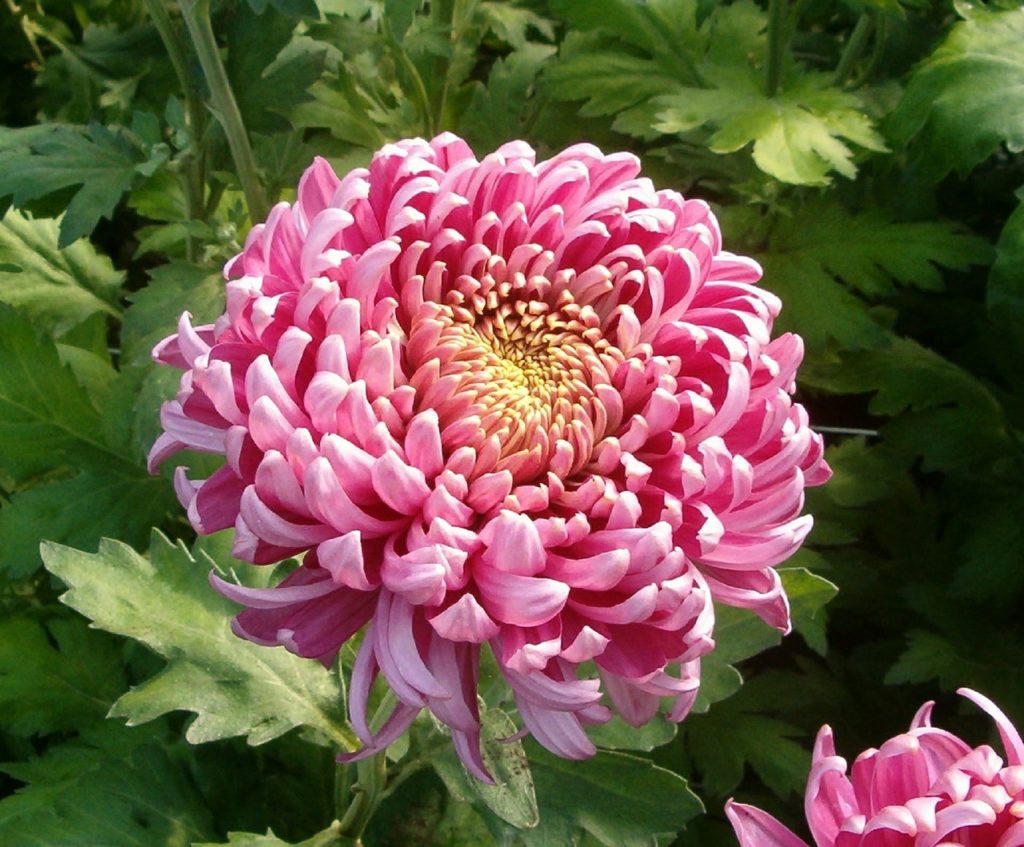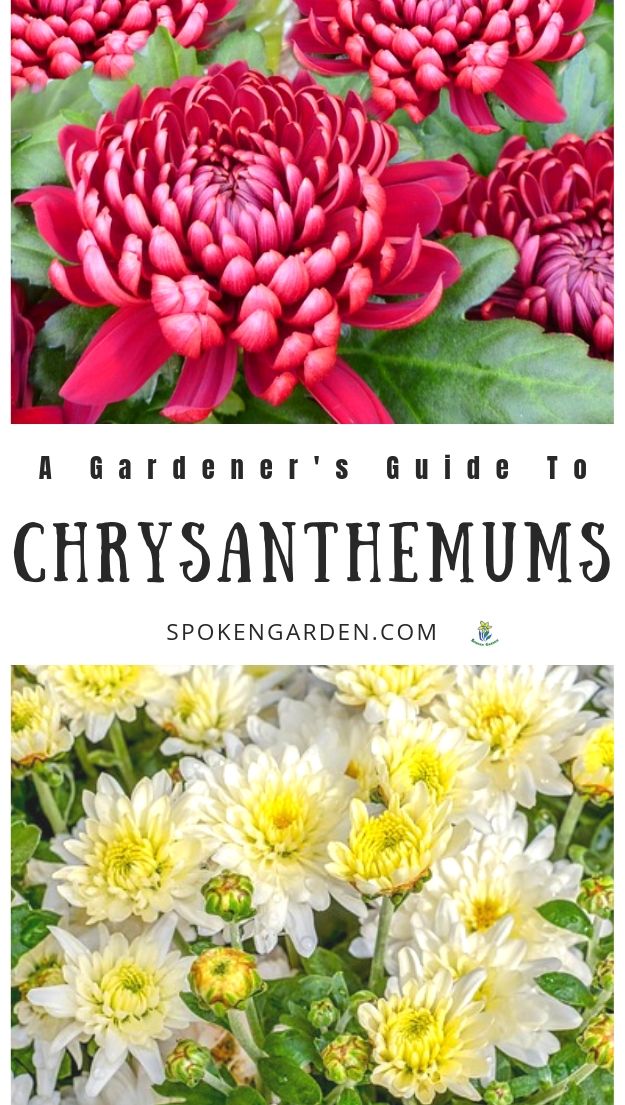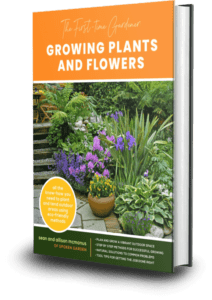Learn all about Chrysanthemums in this gardener’s guide of these beautiful, fall bloomers, including plant care, companion plants, medicinal uses, and more.

Nothing screams fall season like our garden chrysanthemums. Also called “mums”, their flowers are small, colorful, and beautiful.
Revered throughout history for different reasons, their massive commercial success and abundance of cultivars have continued to delight gardeners around the world.
In our plant profile below, you’ll learn about the many benefits this beautiful plant has to offer.
Chrysanthemum Quick Plant Facts
| Sun Exposure | Full sun |
| Water Needs | Regular water. |
| Soil Needs | Well-drained soil with lots of organic matter. |
| Cold-Hardiness Zones | USDA hardiness zones 5 to 9. |
| Bloom Time | Summer to mid-Fall. |
| Flower Colors | Pink, purple, red, yellow, bronze, orange, lavender and white. Also in multi-colors. |
| Mature Height/Width | Can vary, from under 1-foot to 6-feet tall with variable width. |
| Plant Spacing | Can vary, but if spaced closer together, the taller your flower stems will be, in general, and your plant overall. If spaced further apart, the shorter your flower stems will be, in general, and your plant overall. |
Read our chrysanthemum guide below to learn:
- How to maintain and care for chrysanthemums in your garden.
- The best growing conditions for your mums.
- The history of mums.
- Are mums annuals or perennials?
- Fun facts and so much more.
Chrysanthemums: Why We’re Featuring This Plant
First, fall season and garden mums are a perfect fit. Although mums also bloom in the spring, the fall season is where they stand apart and shine. They add beautiful pops of color around the yard and are suitable for both borders and container baskets.
In addition to their beauty, these hardy plants are really easy to maintain. With just a bit of deadheading for spent flowers, mums can be enjoyed throughout most of the fall months and often into the following spring. Plus, they have a long growing season as long as they have proper care, adequate sunlight exposure (at least 5-6 hours daily), and are not immersed in standing water. Their low maintenance needs are perfectly suited for both beginning gardeners and novices alike.
Finally, we’re featuring chrysanthemums because of their variety in size, color, and shape.
Aside from the mums you might buy in stores every fall that look like pom poms, there are so many other types of mums out there to explore including spider mums or anenome mums. In fact, there are 12-13 different flower forms that have been designated for this one plant!
Chrysanthemum Plants: History and Uses
Asteraceae Family
Mums are in the massive Asteraceae plant family. Also known as the daisy family, this family group has more than 20,000 species of flowering plants throughout the world!
The daisy family features some of the most popular flowers in the world including quite a few you have probably heard of before. A quick fun fact is a unique characteristic every member of this family shares. The flowers in this family group are actually made up of two types of flowers, not just one. Each flower you see is composed of one or more rows of “Ray” flowers on the perimeter/edge and the “Disk” flowers in the center. Think of a typical daisy, like a Shasta daisy, they have the white petals (the “rays”) and the yellow centers are actually another flower (the “discs”). Interesting, huh?
Daisy family members are valued for a range of uses, including:
- Cut flowers
- Ornamental gardens
- Cooking oils
- Herbal teas
- Other medicinal uses
Other members of the large Asteraceae family include Shasta daisies, Sunflowers, Blanket flowers, Zinnias, Asters, Black-Eyed Susans, Coneflowers, and Lettuce to name a few (of the many)!
History of Chrysanthemums
Chrysanthemum has a long, storied history going back to 15th Century China. Research suggests that mums were first cultivated there based on drawings, descriptions, and pottery from that time period. They used mums medicinally to calm headaches or brew the leaves into festive drinks, like tea.
Currently, Chrysanthemum tea is still a very popular East Asian beverage. It is believed to offer medicinal properties including the ability to protect your heart, boost your immune system, improve vision, calm your nerves, and many other things.
Symbolically, chrysanthemums have been used to signify everything from life to death throughout the world. In most parts of the world, chrysanthemums symbolize life, joy, and longevity. However, in many European countries, the Chrysanthemum flower symbolizes death and is used as a funeral flower.
Today, mums remain the most widely grown potted plant in the U.S. and are one of the longest-lasting of all the cut flowers.
If you want to read more about the history of chrysanthemums, check out National Chrysanthemum Society, USA.
Chrysanthemums Around the World
The Chinese city of Chu-Hsien translates to “Chrysanthemum City” and was named to honor the flower. This was in direct result of how popular and beloved the flower was in the 15th Century B.C.
Eventually, mums found their way to Japan by the 8th Century A.D. where they became the most beloved flower of that time. In fact, the Japanese people were so enamored by mums they made them the official seal of their emperor! To this day, Japan celebrates “Chrysanthemum Day.”

In our Chrysanthemum plant profile, learn how to properly care for your mums.
By the 17th Century, Karl Linnaeus introduced mums to the Western world. Naming the flower after the Greek words chrysos, meaning gold, and anthemon, meaning flower. Mums grew in popularity and eventually made their way to the U.S. where the rest is history.
Today, mums continue to gain popularity, especially each fall as they adorn American porches and walkways. In addition, they are celebrated through many official Chrysanthemum societies that exist throughout the U.S. and Europe.
Now that you’ve caught up on a brief history, let’s move on to the common characteristics of Chrysanthemums.
Chrysanthemum Care
Chrysanthemums are herbaceous perennials that prefer full sun (at least 5-6 hours a day) and well-draining soil with lots of organic matter. They require regular watering.
Mums could be susceptible to aphids.
Chrysanthemum Companion Plants
Chrysanthemums prefer the cooler temperatures and seek out similar friends.
Mums and most of the companion plants listed below will add color and a continuous supply of beneficial food sources to your landscape throughout most of the fall months when everything else has gone dormant. You really cannot go wrong with a companion for your mums. It simply boils down to your individual preference and color choice.
Companion plants to consider:
- Dianthus
- Dusty Miller
- Dahlias
- Violas
- Rhodys
- Azaleas
- Laurels
- Boxwoods
- Arborvitae
- Ornamental grasses
- Marigolds
Plant Care Supplies
Chrysanthemums are perfect for beginners to more experienced gardeners due to their variety of shapes, sizes, and colors. It’s no wonder they are one of the favorites of the fall garden.
Now that you have learned a bit about their maintenance requirements, you need the proper tools for caring for them. This is a crucial step along your journey to great coneflower plant care, almost as important as choosing the plants themselves. The question is do you have all the tools you need?
If not, below are some recommendations to specific tools we use that will support your coneflower plant maintenance. Or, if you need to shop for other garden plants for this summer or fall, click here to find what you need!
1) For Planting
2) For Watering
You’ll need some type of garden hose for your plants and this is one of the highest-rated on Amazon from Flexzilla. It is flexible, durable, and comes in multiple lengths for whatever size your yard.
Here’s a huge time-saving tip, set up a drip hose and a water timer so you don’t have to waste time, water, or money hand watering your plants.
We love this water timer by Orbit because it is easy to set up, has a manual override option for when you need your hose, and features two hose attachments which is awesome.
3) For Deadheading or Trimming
You will need a good, sturdy pair of pruning shears and these are the best in our opinion! These pruning shears from Corona are super sharp and stay sharp.
These would be perfect for deadheading, snipping, or other general light pruning tasks. We use ours all the time!
Flower Books
If you’re looking for further educational resources about all types of perennials, these books below are great educational references!
The first book is our new eBook which we’re so excited to show you! The two books below that can be found on Amazon at the links below.
Four-Season Gardening
If you want to create a four-season garden featuring specific, beautiful plants that bloom during specific seasons, look no further than our new book!
In Four-Season Gardening, we’ll teach you plant care tips for 15 seasonal plants and seasonal gardening tricks that could be the difference between a thriving garden and a ho-hum garden. Check it out!
American Horticultural Society Encyclopedia of Plants and Flowers
This is a great reference guide for tons of plants from the American Horticultural Society.

Floret Farm’s Cut Flower Garden: Grow, Harvest, and Arrange Stunning Seasonal Blooms
This book has stunning images, how-tos, and planting information to grow your own cutting garden.

Or, if you need to shop for other garden plants for this summer or fall, click here to find what you need!
Chrysanthemum Plant Conclusion
As you have read above, chrysanthemums are perfect additions to your fall garden for their colorful blooms, low maintenance, and abundance of blooms.
Each fall, mums can be found decorating porches and walkways, and high school homecoming dances. They remain the most widely grown potted plant in the U.S. and are one of the longest-lasting of all the cut flowers.
Now it is time to hear from you!
What more do you want to learn about chrysanthemums? Do you have any questions that still need answering?
Leave a quick comment below and let us know!
Want to learn about other plants in your garden? Check out some of our previous plant profiles:
- Shasta Daisy: A Gardener’s Guide and Plant Profile
- Coneflowers: A Gardener’s Guide and Plant Profile
- Crocosmia: A Gardener’s Guide and Plant Profile
- Primroses: A Gardener’s Guide and Plant Profile
- Dianthus: A Gardener’s Guide and Plant Profile
- Grape Hyacinth: A Gardener’s Guide and Plant Profile
- Sunflowers: A Gardener’s Guide and Plant Profile
See you in the garden!
~ Sean and Allison
P.S. Find us on Pinterest, Twitter, Facebook, and Instagram so you don’t miss a thing!
Chrysanthemum Plant References:
- Chrysanthemums – HGTV
- Chrysanthemum– Univesity of Illinois Extension
- National Chrysanthemum Society

Click the graphic above to save “Chrysanthemum plants” to Pinterest for later!
Spokengarden.com is a participant in the Amazon Services LLC Associates Program, an affiliate advertising program designed to provide a means for sites to earn advertising fees by advertising and linking to Amazon.com


